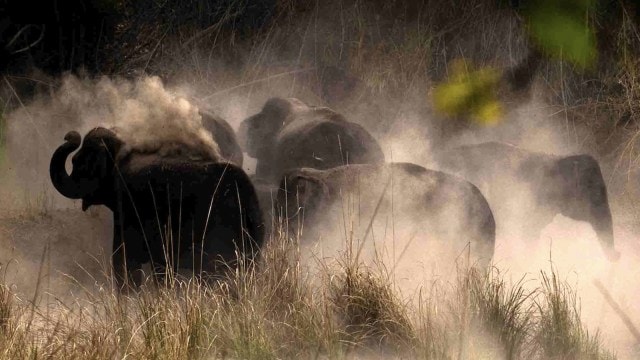10 of its herd dead, lone tusker guards a mass burial in Bandhavgarh reserve
At the Bandhavgarh Tiger Reserve, where the deaths took place, a JCB machine poured sand and salt into an open pit, while wildlife officers placed flowers inside the grave, bidding farewell to the gentle giants.
 Days after 10 elephants died, ostensibly after eating large amounts of kodo millets, the 20-year-old lone surviving male from the herd of 13 elephants is struggling to reconcile with the loss.
Days after 10 elephants died, ostensibly after eating large amounts of kodo millets, the 20-year-old lone surviving male from the herd of 13 elephants is struggling to reconcile with the loss.The funeral was interrupted by the powerful trumpet of a lone elephant, flapping its ears, stomping its feet, and charging at wildlife officials who were burying its family.
Days after 10 elephants died, ostensibly after eating large amounts of kodo millets, the 20-year-old lone surviving male from the herd of 13 elephants is struggling to reconcile with the loss.
At the Bandhavgarh Tiger Reserve, where the deaths took place, a JCB machine poured sand and salt into an open pit, while wildlife officers placed flowers inside the grave, bidding farewell to the gentle giants.
Adjacent to the burial pits is a makeshift post-mortem facility, where veterinarians can hear the lone elephant’s sorrowful mourn. A veterinarian, exhausted from conducting autopsies of the dead tuskers for the past two days, choked with emotion: “Everyone is heartbroken. We could not conduct the post-mortems properly as the elephant would charge at us, thinking it can still save its family. We had to chase it away with JCB machines.”
Pushpendra Nath Dwivedi, a former wildlife warden who has worked closely with the elephants since they arrived in Bandhavgarh in 2018, has been supervising villagers to set up guard posts, and advising them to burn chilli smoke to chase away the lone elephant.
“Elephants came to this area in 2018… calfs, mothers and lone bulls, everyone called Bandhavgarh their home. They were a close knit family and are mourning the loss. The bull keeps returning to the pits where the elephants are buried, hoping to see its family one last time. It should leave for food in some time,” Dwivedi said.
The other survivors are a 10-year-old female elephant and a two-year-old calf. They are being closely tracked by the wildlife department, which has now begun destroying kodo millets and promised to compensate the farmers.
According to experts, elephants roamed freely across Chhattisgarh and Madhya Pradesh centuries ago, when they would be captured by the Mughal army for use in battle. According to the Ministry of Environment, Forest and Climate Change, “a small population of elephants migrated from Jharkhand and Odisha into what was then Madhya Pradesh” due to habitat destruction by mining, logging and industrialisation. This explains why elephants in this corridor had to undertake long-distance migrations seeking refuge in small patches of forest.
On October 31, 2018, a herd of elephants made a significant journey into Bandhavgarh, entering through the Panpatha buffer range from the Shahdol forest division. In the beginning, the elephants “displayed exploratory behaviour, traversing all the ranges”. Then they began raiding crops and destroying forest camps.
“They left after exploring the forest reserves and re-entered the reserve in December, 2018. This time, they decided to stay. A monitoring team was formed to constantly track their movements. The herd began to grow and I had helped in spreading awareness of elephants in 10 villages as part of a project to ensure they were not harmed,” Dwivedi said.
By 2023, Bandhavgarh was home to around 48-50 elephants, divided into three groups, with frequent visits to areas of the Shahdol forest division and Chhattisgarh, officials said.
After the recent deaths, frantic phone calls were made by MP wildlife officers to Dr P K Chandan, the Additional Deputy Director at Kanan Pendari Zoological Garden in Chhattisgarh’s Bilaspur for his guidance.
 Police personnel and other officials at the Bandhavgarh Tiger Reserve after the death of elephants. (PTI)
Police personnel and other officials at the Bandhavgarh Tiger Reserve after the death of elephants. (PTI)
Chandan has worked closely with elephants that routinely enter Madhya Pradesh from Chhattisgarh and has experience in treating elephants with toxic infection from kodo millets.
“Elephants eat kodo all the way from Chhattisgarh to Madhya Pradesh. It is not their preferred meal but they eat it nevertheless. If they eat large amounts, it can cause issues. In Chhattisgarh’s Balrampur and Surajpur, four-five elephants were found unconscious after eating kodo millets, but were treated due to timely intervention. We then tested goats which were fed kodo millets — they also became unconscious and some of them died. It can lead to severe stomach ache and haemorrhage in the intestines, which kills the animal. This happens when it eats over 5 kg of kodo millets,” Chandan said.
Ever since this finding, the Chhattisgarh wildlife department has asked farmers to desist from growing kodo millets and has even offered financial help to erect solar powered electric fences to keep elephants away from farms.
However, in Madhya Pradesh, it’s a different story. Sources in the local wildlife department say there is no such arrangement here.
“The elephant project which was run in these parts suffered from lack of funding. There are no elephant mitras (friends) in the area where the elephants were found dead. There is a staff of four-five officers tasked with patrolling one beat and they could not spot these animals on time. Timely treatment could have saved them. Some posters have been erected by local NGOs on elephant care but villagers don’t understand what is written. The compensation policy is also bad. If they were assured of timely compensation, the villagers would cooperate with the wildlife department,” said a senior official.
For now, wildlife officials are keeping a close eye on the remaining survivors. On Thursday, the male elephant returned, this time with another herd of 25 elephants, and entered a nearby kodo millet farm.
“It’s going to be difficult to destroy all kodo farms. This is a danger to all elephants in Bandhavgarh. We are tracking down all kodo plants and burning them. As for the remaining survivors, they should join a new herd. But they are extremely emotional animals and have a great memory. They will never forget what happened to their family,” Dwivedi said







